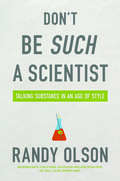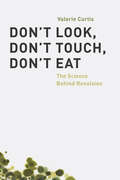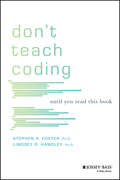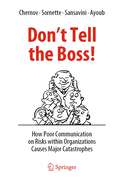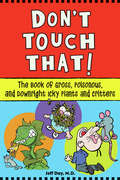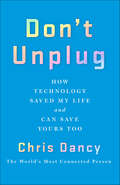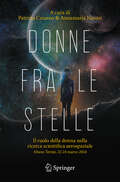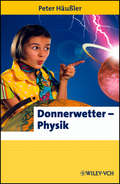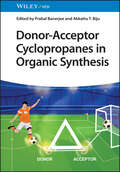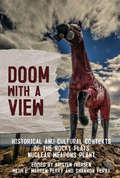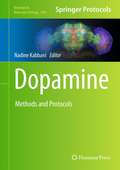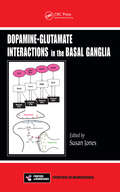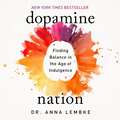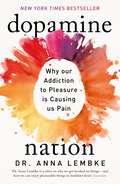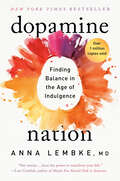- Table View
- List View
Don't Be Such a Scientist: Talking Substance in an Age of Style
by Randy OlsonAfter nearly a decade on the defensive, the world of science is about to be restored to its rightful place. But is the American public really ready for science? And is the world of science ready for the American public? Scientists wear ragged clothes, forget to comb their hair, and speak in a language that even they don't understand. Or so people think. Most scientists don't care how they are perceived, but in our media-dominated age, style points count.Enter Randy Olson. Fifteen years ago, Olson bid farewell to the science world and shipped off to Hollywood ready to change the world. With films like Flock of Dodos: The Evolution-Intelligent Design Circus (Tribeca '06, Showtime) and Sizzle: A Global Warming Comedy (Outfest '08), he has tried to bridge the cultural divide that has too often left science on the outside looking in.Now, in his first book, Olson, with a Harvard Ph.D. and formerly a tenured professor of marine biology at the University of New Hampshire, recounts the lessons from his own hilarious-and at times humiliating-evolution from science professor to Hollywood filmmaker. In Don't Be Such a Scientist, he shares the secrets of talking substance in an age of style. The key, he argues, is to stay true to the facts while tapping into something more primordial, more irrational, and ultimately more human.In a book enlivened by a profane acting teacher who made Olson realize that "nobody wants to watch you think," he offers up serious insights and poignant stories. You'll laugh, you may cry, and as a communicator you'll certainly learn the importance of not only knowing how to fulfill, but also how to arouse.
Don't Eat the Cleaners!: Tiny Fish with a Big Job
by Susan StockdaleEven though they live underwater, ocean animals have to get clean, just like we do. But they get it done in a weird and wonderful way.Just like you have to take a bath and brush your teeth, fish also have basic hygiene practices they have to follow every day. But their approach to cleanliness doesn't just take place underwater—it involves a network of larger ocean animals washed by small fish and shrimp called cleaners at coral reef cleaning stations around the world.Cleaners remove pesky parasites from their customers in return for a tasty meal, serving up to 2000 customers a day. Sea turtles, manta rays, and even sharks line up for a scrubbing in the busy stations, just like at a car wash. Some customers return 100 times daily. And they must remember the important rule if they want a washing by the cleaning crew: DON&’T EAT THE CLEANERS!Readers will delight in this colorful exploration of the remarkable teamwork among coral reef residents. Back matter features images of all 30 animals and a fun matching game: can you find the animals in the book?In her latest nonfiction work, award-winning author-illustrator Susan Stockdale once again proves her talent in creating engaging and entertaining nature books for young readers.
Don't Know Much About the Universe
by Kenneth C. DavisWho dug those canals on Mars? What was the biblical Star of Bethlehem? Were the pyramids built by extraterrestrials?From the ancients who charted the heavens to Star Trek, The X-Files, and Apollo 13, outer space has intrigued people through the ages. Yet most of us look up at the night sky and feel totally in the dark when it comes to the basic facts about the universe.Kenneth C. Davis steps into that void with a lively and readable guide to the discoveries, theories, and real people who have shed light on the mysteries and wonders of the cosmos. Discover why Einstein was such a genius, the truth behind a blue moon or two, the amazing secrets of Stonehenge, and even how one great astronomer lost his nose.With the fun question-and-answer format that has appealed to the millions of readers of his bestselling Don't Much About® series, you'll be taking off on an exciting armchair exploration of the solar system, the Milky Way, and beyond.
Don't Look, Don't Touch, Don't Eat: The Science Behind Revulsion
by Valerie CurtisA scientist delves into what disgusts us and why: “For a book riddled with rancid and revolting things, [it] is surprisingly difficult to put down.” —Times Literary SupplementEvery flu season, sneezing, coughing, and graphic throat-clearing become background noise in workplaces. And coworkers tend to move as far—and as quickly—away from the source of these bodily eruptions as possible. Instinctively, humans recoil from objects that they view as dirty and even struggle to overcome feelings of discomfort once the offending item has been cleaned. These reactions are universal, and although there are cultural and individual variations, by and large we are all disgusted by the same things.In this book, Valerie Curtis builds a strong case for disgust as a “shadow emotion”—less familiar than love or sadness, it nevertheless affects our day-to-day lives. In disgust, biological and sociocultural factors meet in dynamic ways to shape human and animal behavior. Curtis traces the evolutionary role of disgust in disease prevention and hygiene, but also shows that it is much more than a biological mechanism. Human social norms, from good manners to moral behavior, are deeply rooted in our sense of disgust. The disgust reaction informs both our political opinions and our darkest tendencies, such as misogyny and racism. Through a deeper understanding of disgust, Curtis argues, we can take this ubiquitous human emotion and direct it towards useful ends, from combating prejudice to reducing disease.“Curtis, one of the deepest thinkers and cleverest researchers on this part of human nature, turns revulsion into fascination.” —Steven Pinker“Great fun.” —Toronto Star
Don't Teach Coding: Until You Read This Book
by Lindsey D. Handley Stephen R. FosterThe definitive resource for understanding what coding is, designed for educators and parents Even though the vast majority of teachers, parents, and students understand the importance of computer science in the 21st century, many struggle to find appropriate educational resources. Don't Teach Coding: Until You Read This Book fills a gap in current knowledge by explaining exactly what coding is and addressing why and how to teach the subject. Providing a historically grounded, philosophically sensitive description of computer coding, this book helps readers understand the best practices for teaching computer science to their students and their children. The authors, experts in teaching computer sciences to students of all ages, offer practical insights on whether coding is a field for everyone, as opposed to a field reserved for specialists. This innovative book provides an overview of recent scientific research on how the brain learns coding, and features practical exercises that strengthen coding skills. Clear, straightforward chapters discuss a broad range of questions using principles of computer science, such as why we should teach students to code and is coding a science, engineering, technology, mathematics, or language? Helping readers understand the principles and issues of coding education, this book: Helps those with no previous background in computer science education understand the questions and debates within the field Explores the history of computer science education and its influence on the present Views teaching practices through a computational lens Addresses why many schools fail to teach computer science adequately Explains contemporary issues in computer science such as the language wars and trends that equate coding with essential life skills like reading and writing Don't Teach Coding: Until You Read This Book is a valuable resource for K-12 educators in computer science education and parents wishing to understand the field to help chart their children’s education path.
Don't Tell the Boss!: How Poor Communication on Risks within Organizations Causes Major Catastrophes
by Didier Sornette Dmitry Chernov Ali Ayoub Giovanni SansaviniThe book reviews existing research on the challenges of voice and silence in organizations. After a major disaster, when investigators are piecing together the story of what happened, a striking fact often emerges: before disaster struck, some people in the organization involved were aware of dangerous conditions that had the potential to escalate to a critical level. But for a variety of reasons, this crucial information did not reach decision-makers. So, the organization moved ever closer to catastrophe, effectively unaware of the possible threat—despite the fact that some of its employees could see it coming.What is the problem with communication about risk in an organization, and why does this problem exist? What stops people in organizations or project teams from freely reporting and discussing critical risks? This book seeks to answer these questions, starting from a deep analysis of 20 disasters where the concealment of risks played a major part.These case studies are drawn from around the world and span a range of industries: civil nuclear power, coal, oil and gas production, hydropower energy, metals and mining, space exploration, transport, finance, retail manufacturing and even the response of governments to wars, famines and epidemics.Together, case studies give an insight into why people hesitate to report risks—and even when they do, why their superiors often prefer to ignore the news.This helps to explain more generally why people dread passing on bad news to others—and why in the workplace they prefer to keep quiet about unpleasant facts or potential risks when they are talking to superiors and colleagues.The discussion section of the book includes important examples of concealment within the Chinese state hierarchy as well as by leading epidemiologists and governments in the West during the novel coronavirus outbreak in Wuhan in 2019-2020. The full picture of the very early stage of the COVID-19 pandemic remains unclear, and further research is obviously needed to better understand what motivated some municipal, provincial and national officials in China as well as Western counterparts to obfuscate facts in their internal communications about many issues associated with the outbreak.
Don't Touch That!: The Book of Gross, Poisonous, and Downright Icky Plants and Critters
by Jeff DayOffering helpful, humor-laced advice on how to avoid getting stung, bit, poked, jabbed, or poisoned--and what to do if it happens--this guide explains everything from rashes to anaphylaxis, tetanus to spider bites, and cat-scratch fever to rabies, all in kid-friendly language. A strong foundation in biology grounds the discussion, which explains how certain plants and animals can be dangerous and reveals medical information on the physical reactions they can produce. The topical trivia and goofy puns make learning fun both in the classroom and at home.
Don't Unplug: How Technology Saved My Life and Can Save Yours Too
by Chris DancyChris Dancy, the world's most connected person, inspires readers with practical advice to live a happier and healthier life using technologyIn 2002, Chris Dancy was overweight, unemployed, and addicted to technology. He chain-smoked cigarettes, popped pills, and was angry and depressed. But when he discovered that his mother kept a record of almost every detail of his childhood, an idea began to form. Could knowing the status of every aspect of his body and how his lifestyle affected his health help him learn to take care of himself? By harnessing the story of his life, could he learn to harness his own bad habits? With a little tech know-how combined with a healthy dose of reality, every app, sensor, and data point in Dancy's life was turned upside down and examined. Now he's sharing what he knows. That knowledge includes the fact that changing the color of his credit card helps him to use it less often, and that nostalgia is a trigger for gratitude for him. A modern-day story of rebirth and redemption, Chris' wisdom and insight will show readers how to improve their lives by paying attention to the relationship between how we move, what we eat, who we spend time with, and how it all makes us feel. But Chris has done all the hard work: Don't Unplug shows us how we too can transform our lives.
Donne fra le stelle: Il ruolo della donna nella ricerca scientifica aerospaziale, Abano Terme 22- 24 marzo 2024
by Patrizia Caraveo Annamaria NassisiIl libro raccoglie le relazioni presentate alla terza edizione del convegno &“Donne fra le stelle&” che si è svolto ad Abano Terme dal 22 al 24 marzo, 2024. Scienziate e ricercatrici provenienti dai principali istituti, centri di ricerca ed industrie europee si raccontano, come donne e come professioniste, attraverso un linguaggio accessibile e coinvolgente. Il libro offre una visione completa dei problemi e delle opportunità che si trovano ad affrontare nel campo dell&’astrofisica, delle scienze e delle tecnologie spaziali. &“Donne fra le stelle&” è un&’associazione nata dal desiderio di illustrare le meraviglie del cosmo e delle tecnologie spaziali al grande pubblico attraverso la voce di astronaute, astrofisiche, geofisiche, ingegnere aerospaziali e ricercatrici, per rendere protagoniste le donne sottolineandone l&’impegno e i risultati in un ambito scientifico/industriale, dove è ancora nettamente prevalente la presenza maschile. L&’obiettivo dell&’associazione è stimolare i giovani, soprattutto le ragazze, a scegliere le materie STEM (Science, Technology, Engineering e Mathematics) nel loro percorso di studi, evidenziando anche come lo spazio sia diventato un ambiente multidisciplinare. Per questo &“Donne fra le stelle&” organizza simposi itineranti su tutto il territorio nazionale con la collaborazione dei più importanti centri di ricerca e industrie a livello nazionale e internazionale come INAF (Istituto Nazionale di Astrofisica), ASI (Agenzia Spaziale Italiana), ESA (European Space Agency), e NASA e delle industrie come Thales Alenia Space, Telespazio, e tante PMI e start-up.
Donnerwetter - Physik!
by Peter HäußlerJetzt als Sonderausgabe! Auf einer Geburtstagsparty werden Jugendlichen sieben Zauberkunststücke vorgeführt. Sieben erstaunliche Phänomene, die Anne und ihre Freunde zunächst vor Rätsel stellen. Doch so nach und nach kommen sie den Tricks auf die Spur. Mit der Unterstützung eines Nachbarn, einem pensionierten Physiker, entwickeln sie dazu physikalische Ideen: Anhand des Gewichts von Schokolade wird die Einheit für die Kraft diskutiert, "Schau mir in die Augen" leitet ein Gespräch über die Bildentstehung ein. Das Beobachten von Zugvögeln ist Aufhänger für den Magnetismus, und ein heftiges Gewitter gibt Anlass zum Nachdenken über die Elektrizität. Auch die von Physikern entwickelten Vorstellungen zu Quarks, Weißen Zwergen und Schwarzen Löchern kommen zur Sprache. Peter Häußler ist Professor für die Didaktik der Physik an der Universität Kiel und versteht es, lebendig und spannend zu schreiben. Über die Grundlagen der Physik hinaus erfährt der Leser auch etwas über ihre Erkenntnismethoden und den Unterschied zwischen Alltags- und Wissenschaftssprache. Alle Versuche sind genau beschrieben und können ohne großen Aufwand mit alltäglichen Gegenständen nachvollzogen werden. Das Buch ermutigt Jugendliche wie Erwachsene sich (wieder einmal) mit Physik zu beschäftigen, Kenntnisse aufzufrischen oder zu erweitern.
Donor-Acceptor Cyclopropanes in Organic Synthesis
by Akkattu T. Biju Prabal BanerjeeDonor-Acceptor Cyclopropanes in Organic Synthesis Facilitate milder, simpler reactions in organic synthesis with this cutting-edge family of building blocks Donor-Accepted Cyclopropanes, or DACs, have attracted a resurgence of interest from organic chemists in recent decades for their role in facilitating various reactions such as cycloadditions, annulations, ring-opening and enantioselective transformations. The structural arrangement of DACs leads to milder, simpler reaction conditions, which have made them indispensable for a range of fundamentally and industrially important processes. Donor-Acceptor Cyclopropanes in Organic Synthesis covers comprehensively the chemistry and applications of this compound class. The result is an invaluable guide for any researcher looking to bring DACs to bear in their own areas of research or development. Readers will also find: A brief introduction of the history and reactivity of DACs Detailed discussion of reactions including Lewis acid-catalyzed cycloadditions, metal-free activation, asymmetric transformations, organocatalysis, and many more Application of DACs in natural product synthesis and pharmaceutical/agrochemical research Donor-Acceptor Cyclopropanes in Organic Synthesis is ideal for organic chemists, experts in catalysis, pharmaceutical researchers, and any other scientists interested in facilitating milder, simpler reactions.
Doom with a View: Historical and Cultural Contexts of the Rocky Flats Nuclear Weapons Plant
by Kristen IversenTucked up against the Rocky Mountains, just west of Denver, sits the remnants of one of the most notorious nuclear weapons sites in North America: Rocky Flats. With a history of environmental catastrophes, political neglect, and community-wide health crises, this site represents both one of the darkest and most controversial chapters in our nation's history, and also a conundrum on repurposing lands once considered lost. As the crush of encroaching residential areas close in on this site and the generation of Rocky Flats workers passes on, the memory of Rocky Flats is receding from the public mind; yet the need to responsibly manage the site, and understand the consequences of forty years of plutonium production and contamination, must be a part of every decision for the land's future.
Dopamine
by Nadine KabbaniDopamine, a catecholamine transmitter, plays a number of vital physiological roles in the brain and body, and, in recent years, studies on the role of dopamine in disease have opened new avenues of research and discovery. In Dopamine: Methods and Protocols, experts and key figures within the field provide detailed protocols on leading approaches in the study of dopamine within biological systems. Divided into sections on cellular/biochemical, imaging, genetics, and electrophysiology, this collections includes protocols for bioluminescence and fluorescence imaging, receptor immunoprecipitation and proteomic analysis, creation and characterization of a mouse model of Parkinson's disease, real time measurement of dopamine in the brain, and modeling signal transduction in silico. Written in the highly successful Methods in Molecular BiologyTM series format, chapters include introductions to their respective subjects, lists of materials and reagents, step-by-step, readily reproducible laboratory protocols, and tips on troubleshooting and avoiding known pitfalls. Authoritative and convenient, Dopamine: Methods and Protocols serves as an ideal guide for students and experts alike, as well as for anyone interested in exploring the vast and crucial field of dopamine research.
Dopamine - Glutamate Interactions in the Basal Ganglia
by Susan JonesThe basal ganglia are involved in complex brain functions, from voluntary movement control to learning and reward processing, and they are implicated in numerous neurological and psychiatric disorders. Information from the cerebral cortex and thalamus is conveyed to basal ganglia nuclei via glutamate release, while dopamine from the midbrain is rel
Dopamine Nation: Finding Balance in the Age of Indulgence
by Dr Anna LembkeAll around us people are looking at their phones too much, eating too much, drinking too much. Our world is addicted to fleeting distracting pleasures that get us nowhere. Dr Anna Lembke provides a clear way back to a balanced life.This audiobook is about pleasure. It's also about pain. Most importantly, it's about how to find the delicate balance between the two, and why now more than ever finding balance is essential. We're living in a time of unprecedented access to high-reward, high-dopamine stimuli: drugs, food, news, gambling, shopping, gaming, texting, sexting, Facebooking, Instagramming, YouTubing, tweeting... The increased numbers, variety, and potency is staggering. The smartphone is the modern-day hypodermic needle, delivering digital dopamine 24/7 for a wired generation. As such we've all become vulnerable to compulsive overconsumption.In Dopamine Nation, Dr. Anna Lembke, psychiatrist and author, explores the exciting new scientific discoveries that explain why the relentless pursuit of pleasure leads to pain...and what to do about it. Condensing complex neuroscience into easy-to-understand metaphors, Lembke illustrates how finding contentment and connectedness means keeping dopamine in check. The lived experiences of her patients are the gripping fabric of her narrative. Their riveting stories of suffering and redemption give us all hope for managing our consumption and transforming our lives. In essence, Dopamine Nation shows that the secret to finding balance is combining the science of desire with the wisdom of recovery.'Dr Anna Lembke is a whiz on why we get hooked on things - and how we can enjoy pleasurable things in healthier doses.' - The Guardian(P) 2021 Penguin Random House Audio
Dopamine Nation: Finding Balance in the Age of Indulgence
by Dr Anna Lembke'Her stories have the power to transform your life' Lori Gottlieb, bestselling author of Maybe You Should Talk to Someone 'Radically changes the way we think about mental illness, pleasure, pain, reward and stress' Daniel Levitin, bestselling author of The Organized MindTHE NEW YORK TIMES AND SUNDAY TIMES BESTSELLER We are a wired generation. In these fast-paced times we are constantly bombarded by high-reward, high-dopamine stimuli. From texting to social media, food to drugs, gambling to shopping, we have become addicted to fleeting and distracting pleasures that are making us sick.In Dopamine Nation, psychiatrist and bestselling author Dr Anna Lembke reveals why our relentless pursuit of pleasure leads to pain and what we can do about it. Bringing together cutting-edge neuroscience with the gripping real life experiences from her clinical practice, Lembke explores how contentment and connectedness are essential tools in keeping dopamine in check. This is an essential book for anyone wanting to find a balance for a happier life.
Dopamine Nation: Finding Balance in the Age of Indulgence
by Dr. Anna LembkeINSTANT NEW YORK TIMES and LOS ANGELES TIMES BESTSELLER&“Brilliant . . . riveting, scary, cogent, and cleverly argued.&”—Beth Macy, author of Dopesick,as heard on Fresh AirThis book is about pleasure. It&’s also about pain. Most important, it&’s about how to find the delicate balance between the two, and why now more than ever finding balance is essential. We&’re living in a time of unprecedented access to high-reward, high-dopamine stimuli: drugs, food, news, gambling, shopping, gaming, texting, sexting, Facebooking, Instagramming, YouTubing, tweeting . . . The increased numbers, variety, and potency is staggering. The smartphone is the modern-day hypodermic needle, delivering digital dopamine 24/7 for a wired generation. As such we&’ve all become vulnerable to compulsive overconsumption. In Dopamine Nation, Dr. Anna Lembke, psychiatrist and author, explores the exciting new scientific discoveries that explain why the relentless pursuit of pleasure leads to pain . . . and what to do about it. Condensing complex neuroscience into easy-to-understand metaphors, Lembke illustrates how finding contentment and connectedness means keeping dopamine in check. The lived experiences of her patients are the gripping fabric of her narrative. Their riveting stories of suffering and redemption give us all hope for managing our consumption and transforming our lives. In essence, Dopamine Nation shows that the secret to finding balance is combining the science of desire with the wisdom of recovery.
Dopamine Receptor Technologies
by Mario TiberiTo foster a better understanding of dopamine receptor functionality, this detailed volume creates an interface between updated classical methods and new emerging technologies heretofore not available to new or seasoned researchers. Divided in five sections dedicated to experimental approaches investigating different facets of dopaminergic signal transduction, Dopamine Receptor Technologies covers epigenetic and post-transcriptional analysis, computational and biochemical techniques, visualization and imaging methods, molecular and cell biological tools, as well as behavioral assessment. The book, as a part of the popular Neuromethods series, provides insightful step-by-step protocols and methodological reviews that readers will find useful. Practical and versatile, Dopamine Receptor Technologies seeks to aid researchers in developing new pharmacological tools to improve our knowledge of in vivo roles played by each receptor subtype and the synthesis of prospective lead compounds for drug discovery.
Dopamine Receptors and Transporters: Function, Imaging and Clinical Implication, Second Edition
by Philippe Vernier Anita Sidhu Marc Laruelle"Details the function, characterization, and physiology of various dopamine receptor/transporter systems and explores their role in etiology, diagnosis, and disease management."
Dopamine and Sleep
by Jaime M. Monti S. R. Pandi-Perumal S. ChokrovertyThis book offers a comprehensive but highly readable compilation of papers on the role of dopamine in sleep and sleep disorders. Leading experts in sleep medicine, psychiatry and neuroendocrinology provide a broad perspective on the field, from established theories to the latest research advances. Accordingly, it represents an interdisciplinary, cutting-edge guide for sleep disorder specialists, sleep researchers, psychiatrists, neurologists, pulmonologists, psychologists, and behavioral sleep medicine specialists.
Dopamine in the Gut
by Jin-Xia ZhuDopamine is widely present in the central and peripheral nervous systems, as well as in non-nervous systems. Parkinson's disease is well recognized as a dopaminergic neurodegenerative disorder, and affected patients often show early signs of gastrointestinal disorders at initial stages of the disease. Apart from the changes that occur in emotion, movement behaviors, learning and memory, metabolism etc., dopamine has also been demonstrated to play very crucial roles in the functional regulation of peripheral organs such as the heart, blood vessels, kidneys, and gut. Most recently, dopamine function in the gut has received enormous attention. Not only does dopamine regulate gut motility, ion transport, and mucosal barrier, but it is becoming more pertinent that more than 60% of dopamine in the body stems from the gut, which has not yet been properly addressed and substantially explored. Therefore, this book will discuss the brain-gut axis by providing novel and significant insight into the essence of gut-derived dopamine in mammals. It aims to inspire further research on dopaminergic regulation of gut function and disease genesis.
Dopamine: Endocrine and Oncogenic Functions
by Nira Ben-JonathanDopamine is a small molecule traditionally regarded as a brain-derived neuronal modulator implicated in many neurological and psychiatric disorders. Outside the brain, dopamine fulfills all the criteria of a circulating hormone which affects normal and abnormal functions of multiple organs and regulatory systems and is also involved in many aspects of cancer formation and progression. This book provides a much needed systematic account of dopamine as an endocrine and autocrine/paracrine hormone and fills a major gap in the overall understanding of the production, distribution and actions of this very important molecule. Key Features: Explores the many different faces of dopamine as autocrine, paracrine and endocrine molecule Documents the adverse effects of antipsychotics on dopamine functions Reviews the many ways dopamine affects the cardiovascular, renal and reproductive systems Provides updates on receptor oligomerization and signaling Examines the role of dopamine in tumorigenesis Related Titles Jones, S. ed. Dopamine - Glutamate Interactions in the Basal Ganglia (ISBN 978-0-3673-8197-4) Luo, L. Principles of Neurobiology (ISBN 978-0-8153-4494-0) Sidhu, A. et al., eds. Dopamine Receptors and Transporters (ISBN 978-0-8247-0854-2)
Dopants and Defects in Semiconductors
by Matthew D. McCluskey Eugene E. HallerPraise for the First Edition "The book goes beyond the usual textbook in that it provides more specific examples of real-world defect physics … an easy reading, broad introductory overview of the field" ―Materials Today "… well written, with clear, lucid explanations …"―Chemistry World This revised edition provides the most complete, up-to-date coverage of the fundamental knowledge of semiconductors, including a new chapter that expands on the latest technology and applications of semiconductors. In addition to inclusion of additional chapter problems and worked examples, it provides more detail on solid-state lighting (LEDs and laser diodes). The authors have achieved a unified overview of dopants and defects, offering a solid foundation for experimental methods and the theory of defects in semiconductors. Matthew D. McCluskey is a professor in the Department of Physics and Astronomy and Materials Science Program at Washington State University (WSU), Pullman, Washington. He received a Physics Ph.D. from the University of California (UC), Berkeley. Eugene E. Haller is a professor emeritus at the University of California, Berkeley, and a member of the National Academy of Engineering. He received a Ph.D. in Solid State and Applied Physics from the University of Basel, Switzerland.
Doping in Conjugated Polymers (Polymer Science and Plastics Engineering)
by Pradip KarAn A-to-Z of doping including its definition, its importance, methods of measurement, advantages and disadvantages, properties and characteristics—and role in conjugated polymers The versatility of polymer materials is expanding because of the introduction of electro-active behavior into the characteristics of some of them. The most exciting development in this area is related to the discovery of intrinsically conductive polymers or conjugated polymers, which include such examples as polyacetylene, polyaniline, polypyrrole, and polythiophene as well as their derivatives. "Synmet" or "synthetic metal" conjugated polymers, with their metallic characteristics, including conductivity, are of special interest to researchers. An area of limitless potential and application, conjugated polymers have sparked enormous interest, beginning in 2000 when the Nobel Prize for the discovery and development of electrically conducting conjugated polymers was awarded to three scientists: Alan J. Heeger, Alan G. MacDiarmid, and Hideki Shirakawa. Conjugated polymers have a combination of properties—both metallic (conductivity) and polymeric; doping gives the conjugated polymer's semiconducting a wide range of conductivity, from insulating to low conducting. The doping process is a tested effective method for producing conducting polymers as semiconducting material, providing a substitute for inorganic semiconductors. Doping in Conjugated Polymers is the first book dedicated to the subject and offers a comprehensive A-to-Z overview. It details doping interaction, dopant types, doping techniques, and the influence of the dopant on applications. It explains how the performance of doped conjugated polymers is greatly influenced by the nature of the dopants and their level of distribution within the polymer, and shows how the electrochemical, mechanical, and optical properties of the doped conjugated polymers can be tailored by controlling the size and mobility of the dopants counter ions. The book also examines doping at the nanoscale, in particular, with carbon nanotubes. Readership The book will interest a broad range of researchers including chemists, electrochemists, biochemists, experimental and theoretical physicists, electronic and electrical engineers, polymer and materials scientists. It can also be used in both graduate and upper-level undergraduate courses on conjugated polymers and polymer technology.
Doping in Sports
by Peter Hemmersbach Detlef ThiemeDoping in sports and the fight against it has gained increasing attention in recent years. The pharmacological basis for a possible performance enhancement in competitive sport through the administration of prohibited substances and methods as well as the analytical disclosure of such practices are comprehensively covered in 21 contributions by outstanding and distinctive authors.
